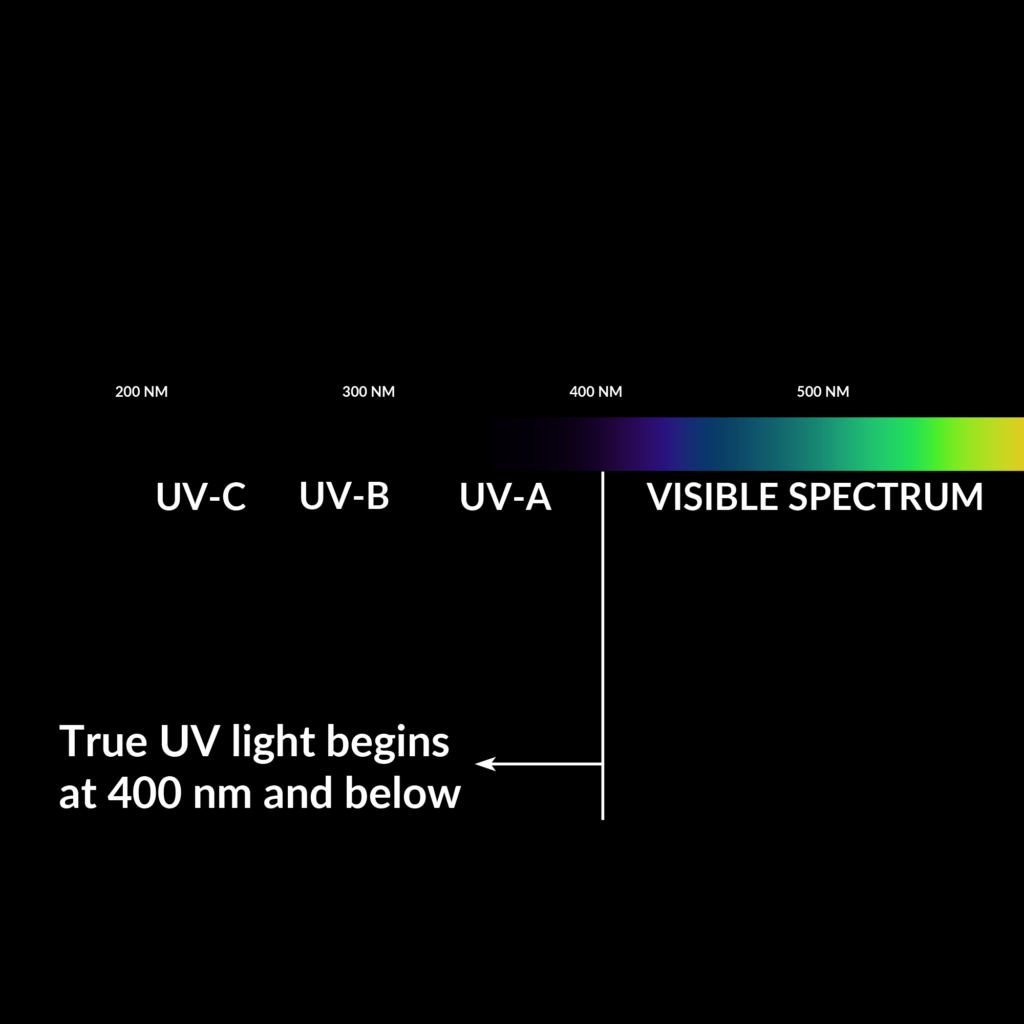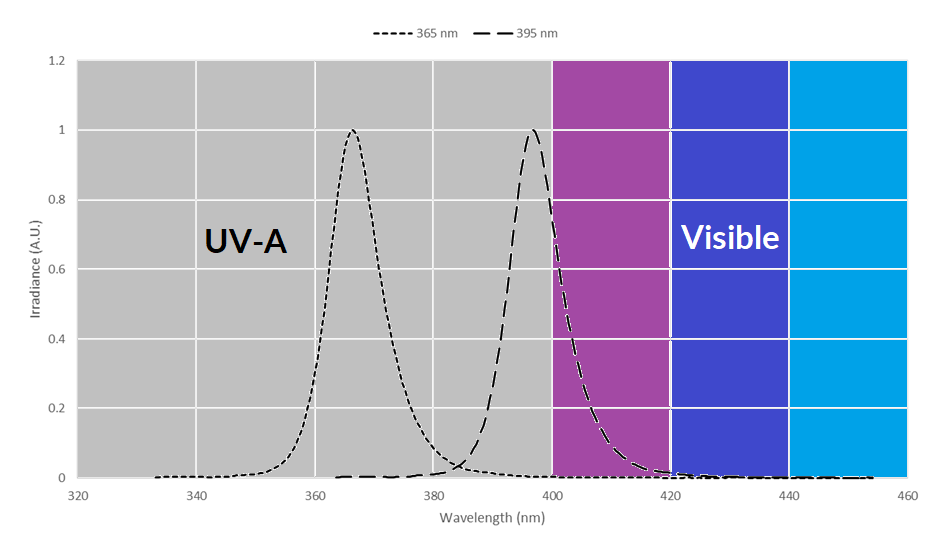一套荧光检漏套装解决工业设备泄漏
LUYOR-6801荧光检漏仪是美国路阳公司生产的荧光检漏仪套装,适用于检查小到中等规模的油基液体系...
2024-03-28作者:上海路阳仪器时间:2022-01-20 10:49浏览36915 次
395 nm LED 比 365 nm LED紫外线灯发出更多的可见光。395 nm LED紫外线灯发出明显的紫色光,而 365 nm LED 发出暗淡的蓝白色光(残余光能“拖尾”进入可见光谱的结果)。两种类型都在 UV-A 波长范围内发射,并且通常能够产生“黑光”或固化效果。
365 nm 和 395 nm紫外线灯的差异
365 nm 和 395 nm 选项都在 UV-A 波长范围内。一般而言,UV-A紫外线灯可用于产生和观察荧光效果,以及用于塑料和油漆固化。与更强的 UV-B 和 UV-C 射线相比,UV-A 波长更安全。

那么,30 nm 的差异意味着什么呢?
主要区别在于 395 nm LED 比 365 nm LED紫外线灯发出更多的可见光。395 nm LED紫外线灯发出明显的紫色光,而 365 nm LED 发出暗淡的蓝白色光(残余光能“拖尾”进入可见光谱的结果)。两种类型都在 UV-A 波长范围内发射,并且通常能够产生“黑光”或固化效果。

为什么可见光量有差异?
上图显示了 365 nm(窄虚线)和 395 nm(宽虚线)LED 的光谱输出图。您会注意到,365 nm 和 395 nm LED都在高于和低于各自波长的波长范围内发射。换句话说,395 nm LED 不会仅在 395 nm 处发光。
395 nm LED 在 395 nm(由术语峰值波长定义)发射最强,但它也在 400 nm 甚至 410 nm 发射相当多的能量。这些波长固定在光谱的可见紫色部分。
当然,395 nm LED 也会发出低于 395 nm 的波长,这些波长的光能在产生荧光效应或引发 UV-A 反应方面非常有效。但是,如图所示,重要的是要注意大部分光能是在可见的紫色区域发射的。
相反,查看 365 nm 光谱输出,您会注意到几乎所有的光能都仅在不可见的 UV-A 范围内,发射能量在达到 400 nm 之前逐渐减少。与可见光能量相比,这将使 UV-A 能量的量更大化,并且对于大多数 UV-A 应用来说是优选的。
但是,当照亮 365 nm LED 时,您可能会注意到发出暗淡的蓝白色光。这是由可见光“泄漏”引起的,其中也发射了微量但可见的可见波长能量(即白光)。这种可见光能量的比例非常小,以至于在光谱图中显示为“0”,但在某些应用中,例如紫外线摄影,可见光确实是可检测到的,可能会令人讨厌。在这种情况下,可能需要额外的可见光过滤技术。
365 nm 紫外线灯荧光比395nm紫外线灯强
除了具有不发射紫光的优点的 365 nm 紫外光外,许多物体在 365 nm 处会发出最强的荧光,如吸收光谱测量所证明的那样。

结果是 365 nm 光可能更适合需要更强荧光效果的应用。再加上发出的可见紫光量较少的优势,365 nm 光可以被认为是性能至关重要的更佳选择。
上海路阳仪器有限公司提供多种款式的365nm led紫外线灯,详情请拨打免费咨询电话咨询:4006-254-365,或微信扫描下方二维码添加微信咨询:

365 nm and 395 nm for UV-A Applications
Both 365 nm and 395 nm options are within the UV-A wavelength range. Generally speaking, UV-A lights are useful for creating and observing fluorescence effects, as well as for plastics and paint curing. UV-A wavelengths are safer when compared to stronger UV-B and UV-C rays.
What then, will a difference of 30 nm mean?
The main difference is that the 395 nm LED emits much more visible light than the 365 nm LED. The 395 nm LED emits a pronounced violet-colored light, while the 365 nm LED emits a dull, bluish-white light (the result of residual light energy that "tails" off into the visible spectrum). Both types emit in the UV-A wavelength range and are generally capable of producing "blacklight" or curing effects.
Why is there a difference in the amount of visible light? The chart above shows the spectral output diagram of both the 365 nm (narrow dotted line) and 395 nm (wide dotted line) LEDs. What you will notice is that both 365 nm and 395 nm LEDs emit over a range of wavelengths both above and below their respective wavelengths. In other words, 395 nm LEDs don't emit at only 395 nm.
The 395 nm LED emits strongest at 395 nm (as defined by the term peak wavelength), but it also emits quite a bit of energy at 400 nm, and even 410 nm. These wavelengths are solidly in the visible, violet portion of the spectrum.
Of course, the 395 nm LED also emits at wavelengths below 395 nm as well, and the light energy at these wavelengths are very effective at creating fluorescence effects or initiating UV-A reactions. But, as the chart shows, it is important to notice that a significant portion of the light energy is being emitted in the visible, violet region.
Conversely, looking at the 365 nm spectral output, you will notice that virtually all of the light energy is within the invisible UV-A range only, with emission energy tailing off before reaching 400 nm. This will maximize the amount of UV-A energy compared to visible light energy and is preferred for most UV-A applications.
When illuminating a 365 nm LED, however, you will likely notice a dull, bluish-white color emitted. This is caused by visible light "leakage" where minuscule but visible amounts of visible wavelength energy (i.e. white light) are also emitted. The proportion of this visible light energy is so small that it is shown as "0" in the spectral charts, but in some applications such as UV photography, the visible light is indeed detectable and may be a nuisance. In such cases, additional visible light filtering techniques may be necessary.
365 nm for Strongest Fluorescence
In addition to 365 nm UV lights having the advantage of not emitting violet light, many objects will fluoresce strongest at 365 nm, as evidenced by absorption spectrum measurements.
The result is that 365 nm light may be better suited for applications where stronger fluorescence effects are desired. Coupled with the advantage of having a lower amount of visible, violet light emitted, 365 nm light can considered an optimal choice where performance is of paramount importance.